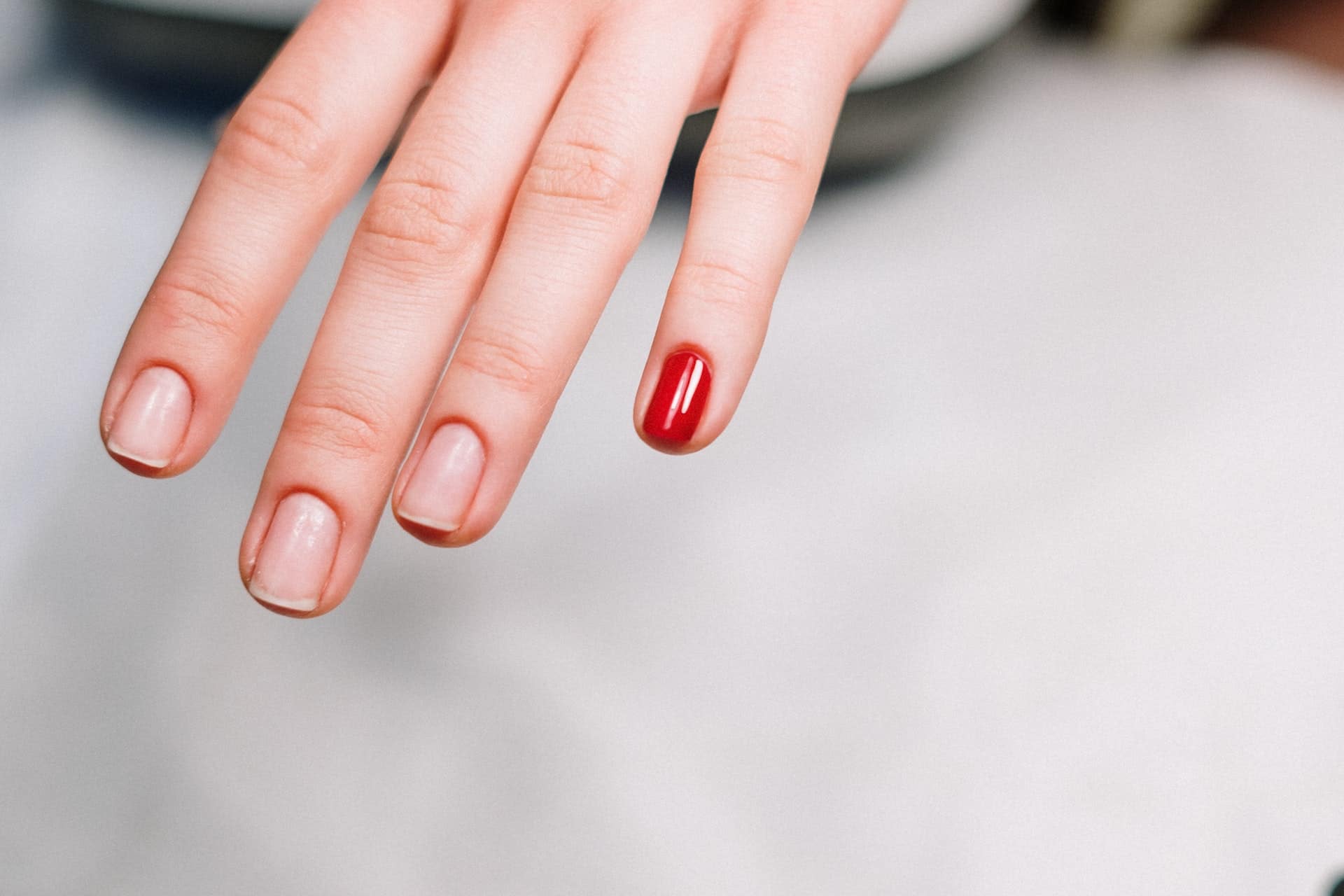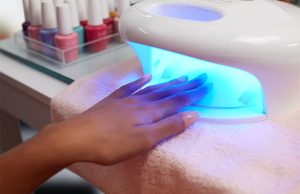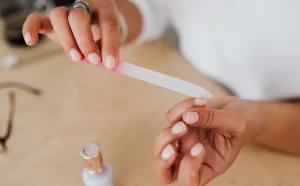You found our guide on How to Remove Gel Nail Polish at Home!
If you can’t make it to a nail salon, then you must know how to remove your gel nail polish at home. You may lose a layer of your natural nail plate if you are removing gel nail polish at home incorrectly, thus plucking or pulling off the paint might cause major long-term harm to your nail beds. You may also experience weak, thin, and worn nails which can break easily.
OPI’s North American Education Manager, Sigourney Nunez says, “It’s not just the color you’re removing. It’s very likely you’re peeling a layer of your natural nail plate too.” The good news is that with what you most likely already own, you can quickly remove the long-lasting chip-resistant UV manicure. To begin again and maintain the health of your nails, we offer a simple guide for how to take off gel nail polish at home.
So, let’s get into it!
What Is Gel Nail Polish?
Gel nail polish is a type of varnish that is cured using ultraviolet lamps. Advocates claim that the gel formulas are much more useful than regular manicures because they don’t chip for at least two weeks. Similarly, gel polishes are softer than other overlays, allowing natural nails to remain strong and healthy.
The Benefits of a Gel Manicure
Gel manicures are designed to last longer than traditional manicures since they are cured and toughened under LED light to reduce chipping. Furthermore, because these manicures are long-lasting, you can limit the number of trips you make to your local nail shop, thus saving you money.
However, it should be noted that gel manicures have certain drawbacks as well. For example, if you are frequently exposed to UV light, which cures the polish, it may be harmful to your skin and nails. Additionally, if you do not know how to remove gel nail polish at home, then it may damage your nails.
Interested in more nail care tips? Check out How Long Do Gel Nails Last? A Practical Guide to Hard Gel vs. Soft Gel.
Supplies You’ll Need to Remove Gel Nail Polish
Before you begin, to remove gel nail polish you will need these items:
- A nail file
- Cotton balls
- A cuticle pusher
- 100% acetone
- A nail buffer
- Aluminum foil
- Cuticle oil
- Towel
Acetone, cotton balls, aluminum foil, a cuticle pusher, and a nail file are the basic supplies you will need to remove gel nails at home. Other items that help maintain healthy nails, but do not require any use, are cuticle oil and nail buffers.
What You Should Do Before Removing Gel Nail Polish
Before you remove your gel nail polish, take a look at these tips:
- When removing gel polish at home, it is better to work on one hand at a time
- Set up an area that is well-ventilated—acetone has a very powerful odor
- Acetone can create stains on your work surface, so you should cover it with a towel to prevent damage
- Cut 10 pieces of aluminum foil that are large enough to wrap around the tip of each finger
- If you use cotton balls, remove 10 pieces that are large enough to cover each nail bed
Let’s get to it!
How to Remove Gel Nail Polish at Home Like a Pro
Follow these six easy steps for the best way to remove gel nail polish at home.
Step 1. File your nail bed with a nail file
File down the gel topcoat layer with a coarse nail file until the topcoat is no longer shiny and smooth. Every nail should be filed down.
Begin by filing your non-dominant hand’s gel topcoat. With the flat face of a nail file, file your nail from the cuticle to the edge in a left-to-right motion, not a back-and-forth motion. Do not focus on a single point. You reveal the gel polish on your nail plate by filing down the gel topcoat. This will make it easier to remove the gel polish afterwards with the acetone.
Step 2. Soak cotton balls with acetone
If you’re going to use cotton balls, cut out sections that will cover the nail bed, making sure they’re thin and large enough. The cotton ball should not be so huge that it comes into contact with the surrounding skin or cuticles.
Soak a cotton ball in acetone until it is damp but not soaked. It usually takes 5 to 10 drops of acetone to accomplish this. Too much acetone on a cotton ball can cause moderate skin irritation, causing the skin to become red, dry, or cracked.
If you’re using cotton pads, dab some acetone on them so they’re damp but not dripping wet.
Continue to the following step by placing the acetone-soaked cotton on top of a fingernail.
Step 3. Wrap the tip of the finger in aluminum foil
Wrap the fingertip with the pre-cut aluminum foil you made earlier to keep the moistened cotton ball in place.
Steps 2 and 3 can now be repeated for each fingernail until all of your fingers are covered in aluminum foil and cotton balls. Wait 10 minutes after wrapping each nail to allow the acetone to seep into the gel polish. The gel nail paint should be softened and bubbling/curling after 10 minutes. This allows you to remove the foil and cotton ball from the nail.
Step 4. Use a cuticle stick to remove gel polish
With a metal cuticle pusher or an orangewood stick, gently shake the gel polish off one nail at a time.
Continue to soak the nails in acetone cotton balls for another 5 minutes if gel polish can’t be removed easily.
Step 5. Buff your nails
Lightly buff your nails to smooth the surface and remove ridges and uneven edges. Remove any remaining pieces of visible gel polish.
Remember that excessive buffing of fingernails can thin the nail plate, weaken your nails, and make gel polish tough to adhere to. This occurs when overly buffed nails bend excessively, causing the gel polish to readily split from the nail plate.
Step 6. Apply Cuticle Oil on Your Nail
Using acetone to remove gel polish is harmful to your nails and skin. Acetone dries out your skin and makes your nails feel rough to the touch. To keep your nails healthy and strong, rehydrate your cuticles with cuticle oil.
Using your fingertips, massage the cuticle oil into your cuticles until they are completely covered.
There is no such thing as over-application of cuticle oil. Apply cuticle oil up to three times each day if you believe it is worthwhile to keep your nails and skin in good shape.
Amy’s Tips to Avoid Nail Damage During Gel Nail Polish Removal
To prevent nail damage and breakage after removing gel nail polish at home, you should:
- Ensure you aren’t using an electric file. As a result, the electric file may cause damage to the natural nail plate, which may lead to thinning, cracking, splitting, or peeling of the nails.
- Don’t pick or peel at the nail. Peeling off gel polish might harm your nails. When you peel off any nail addition, you take off layers of your nail plate, weakening your nails and causing them to chip more. It’s a never-ending cycle. The bond between your nail and the polish weakens with time, allowing the gel to pull away.
- Use acetone to remove polish. According to Shari Lipner, a board-certified dermatologist, acetone is the best way to remove gel nail polish at home. Acetone weakens the bonding in gel polish, making it simpler to remove. However, acetone can be harsh on your nails and skin, so use it with caution.
- Replenish moisture to your cuticle with cuticle oil. Cuticle oil can help hydrate and repair your cuticles and nails. Cuticle oil improves circulation and stimulates nail growth. It can also help to protect your cuticles and nails from harm. The oil can also help with the health and appearance of your nails.
- Gently buff nails with a grit file before soaking them with acetone. Filing your nails before soaking them allows the acetone to dissolve the lacquer. The suggested grit for filing your nails before soaking them is 100/180 grit.
Frequently Asked Questions
Can I peel off gel nail polish?
Peeling off gel nail polish is not advised since it can harm your nails. When you remove gel polish, you also remove the top layer of your natural nail, which can result in thinning, weakening, and sensitivity. Furthermore, pulling off gel polish can cause your nails to crack, split, and peel. Instead, use acetone, cotton balls, aluminum foil, and a nail file to remove gel polish from your nails. To efficiently remove gel polish at home, follow the instructions in the guide above.
Can I speed up the removal process by soaking longer?
Soaking your nails in acetone for a longer period of time may not necessarily speed up the removal of gel nail paint. Indeed, soaking your nails for an extended period of time can cause your skin to dry out and your nails to become brittle. You can try to speed up the process by using pure acetone, plastic-backed cotton pads, making sure your file enough to break the gel seal, use a low grit file, make sure to file the nail evenly, and the nail should look matte after filing.
My nail polish isn’t coming off easily, what should I do?
You might attempt the following methods to remove stubborn gel polish:
Run your finger under lukewarm water and carefully push the gel off your natural nail with a finger from your free hand. Go slowly to cause the least amount of damage.
If the polish won’t come off with water, apply olive oil or cuticle oil to your nail and try again. Remove any residual gel with a nail file. Cuticle oil and hand cream will nourish your nails and your hands.
Can I apply a new gel polish immediately after removal?
Yes, immediately after removal of the gel polish, it is possible to use new gel polish. But before you apply the new coat of color, it is important to make sure that your fingernails are smooth and dry. To remove any residual residue of the preceding polish, a nail buffer may be used to lightly sand your nails.
Is it normal for my nails to feel weaker after gel polish removal?
The result of over buffing the nail surface during the preparation and improper removal of gel polish is that nails become weak or thin after repeated application of gel polish. If you notice that after a gel polish has been removed your nails are becoming weaker, it may be because they were too hard to remove.
How often can I apply gel polish without damaging my nails?
To avoid smothering the nail plate, it’s best to space out your gel manicures. Nail technicians advise that obtaining gel nails every two weeks can cause nail dryness and eventually fracture. Even though your manicure looks good after two weeks, you risk harming your nails if you leave it on for any longer. It is also advised to leave your nails bare for 1-2 weeks between manicures. This aids in the strengthening, healing, and rehydration of the nails. It also allows people to inspect their nails for flaws such as cracks, stains, and discolorations. It’s crucial to know that overextending gel manicures can cause weakening nails as well as the introduction of potentially hazardous bacteria. It is extremely important to note that as the gel begins to lift, moisture can enter under the gel and potentially contribute to bacterial development.
Conclusion
You’ve just removed your gel manicure like a pro, fully from the comfort of your own home—without having to make an expensive trip to the nail salon! This means your nails will already be setup and ready for your next appointment with your nail tech. You’ll be able to get rid of the gel polish at home without any damage if you follow the above steps.




